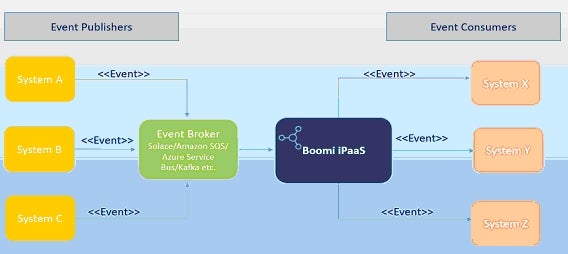The world is becoming ever more connected through ongoing technology evolution and innovation. With the advancement of digitization, organizations are striving to deliver on consumer and business expectations for everything to be real-time and just one click away.
That’s the ideal of the event-driven business. IT systems can respond instantaneously to any event — an ecommerce order, a customer support inquiry, an inventory update request, or steps in employee onboarding. In essence, any human or machine interaction is an event.
The concept of an event-driven business is simple, but it’s at odds with traditional IT architectures. As it is, conventional systems are tightly coupled, periodically polled for updates, and programmed to send a specific request (an event) to a specific system.
That rigid point-to-point architecture introduces a lot of IT overhead and lag time, especially in complex hybrid IT landscapes of cloud and on-premises systems, public and private cloud platforms, and technologies such as IoT devices, AI, and microservices. It’s a barrier to real-time business and strategic objectives for digital transformation.
EDA Advantages for IT and the Business
Enter the event-driven architecture. EDA is not a new concept, but the demands of digital business have put EDA front and center as enterprises work to digitally transform operations to improve speed, agility, and user engagement.
EDA relies on an event broker (also known as a message broker) to orchestrate asynchronous interactions among applications in a publish-subscribe messaging pattern. With an event broker as middleman, event-triggered messages from one system (the publisher) are pushed as they happen to consuming systems (subscribers) to trigger downstream actions.
At OSI Digital, a top-level Boomi Elite partner providing business and technology solutions, we’re seeing growing adoption and interest around EDA as organizations seek to capitalize on benefits such as:
- Increased agility of loosely coupled applications, without the inflexible dependencies of tight coupling
- Real-time business analytics and responsiveness that improves customer, supplier, partner, and employee experiences
- Improved scalability, resilience, high availability, and fault tolerance across a distributed IT infrastructure
- Greater speed and simplicity to incorporate new publishing and subscribing systems
“An EDA brings real-time situational awareness to operations,” as the analyst firm 451 Research says in a report. “It can provide business functions greater agility to adapt to change through more efficient integration and orchestration of services and serverless functions that can compose applications.”
Boomi’s Critical Role in an EDA
The Boomi Enterprise Platform integration platform as a service (iPaaS) supplies a critical advantage in building an EDA, and that’s great news for organizations looking to adapt their infrastructure for the event-driven world.
Boomi has taken the lead among iPaaS vendors in delivering pre-built connectors and broad support for event-driven technologies such as Solace, Kafka, Pravega, Amazon Simple Queuing Service (SQS), Amazon EventBridge, Google PubSub, Rabbit MQ, Salesforce Platform Events, Microsoft Azure Service Bus, and many others.
Boomi’s pre-built connectors spare IT teams from having to reinvent the wheel. Using a pre-built Boomi connector to a Kafka or Solace event broker, for instance, eliminates the need for custom coding and regression testing, which can consume valuable time and resources.
EDA From the Integration Architect Perspective
Key questions for integration architects, as well as CIOs and business executives, is how incorporating an EDA would impact existing systems, and the associated cost and IT resources required.
The beauty of EDA and Boomi’s array of event-driven technology connectors is that architects can approach EDA as an augmentation to a traditional environment, such as a service-oriented architecture (SOA). Existing systems can remain intact as architects introduce an event layer that delivers EDA benefits without a massive “rip and replace.”

A typical EDA with Boomi iPaaS
From a practical perspective, integration architects identify the event publishers and events to be published to an event broker of their choice. Then, it’s easy to configure the Boomi Enterprise Platform, via its drag-and-drop interface, to read events from the broker, perform data transformation and enrichment, and apply business logic to route events to consumer systems.
With EDA, integration architects can replace the traditional synchronous request-response model wherein a source system waits for a response before going to the next step. EDA equips architects to build a loosely coupled system that functions asynchronously, as events happen — not when technology periodically checks for an update.
The EDA model delivers several benefits important to integration architects, with ability to:
- Improve fault tolerance and eliminate the risk of data loss as event brokers allow past events to be “replayed”
- Flexibly distribute event notifications and implement asynchronous API/workflow patterns
- Accommodate events triggered by both human-to-machine and machine-to-machine interactions
- Create data streams comprised of sequences of related events, e.g., triggered by an IoT device, a user visiting a website, or changes to a database
Faster Time to Deployment and Business Value
Integration architects are also equipped to quickly add new systems to meet business requirements. For example, let’s say the business has a new use case that requires ecommerce order data to be pushed to a new analytics application to support data-driven business decisions.
With EDA, IT personnel can easily add the new analytics application as a subscribing consumer to the existing ecommerce order system (the publisher) to receive all details. The model for this new use case can be built without affecting the existing system, which minimizes regression testing time and costs.
As new technologies and use cases multiply, this rapid time to deployment and value is one of the critical advantages available through an EDA supported by Boomi. IT teams can avoid many weeks of development work with prebuilt components that can be reused as needs arise.
Multiple Use Cases Across Industries
EDA is being embraced across industries including manufacturing, ecommerce/retail, healthcare, telecommunications, logistics, media/entertainment, and others. It’s especially useful in organizations with process workflows based on IoT sensor devices that depend on machine-to-machine communications.
EDA supports consumer-facing use cases — for example, booking a cab, placing an ecommerce order, telehealth medical consultations, or streaming a movie without interruption. It’s equally applicable in machine-to-machine scenarios, which are becoming more common in the digital world.
A simple example: If a motorist violates a speed limit, a radar gun can capture details and publish the event to a consuming application that issues a fine to the motorist. It’s a strictly machine-to-machine workflow with no human interaction required — except, of course, for the unfortunate motorist who has to pay the fine.
Learn More About What EDA Offers
As digitization evolves, it’s clear that traditional architectures are not ideally suited to modern business needs for highly available, always-on immediacy based on events.
If implemented effectively, EDA provides enterprises with reduced integration effort that accelerates time to business value. Organizations incorporating EDA can unlock data insights faster while meeting the demands of customers, suppliers, and employees with real-time responsiveness.
To learn more about event-driven architecture and learn how OSI Digital and Boomi can help your organization build an EDA, contact OSI Digital.

 English
English 日本語
日本語